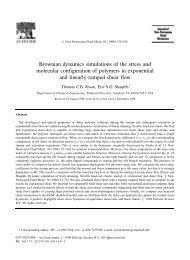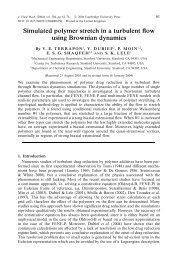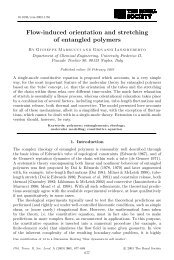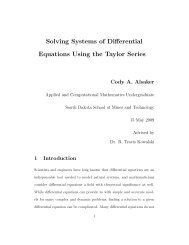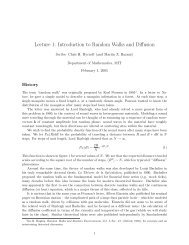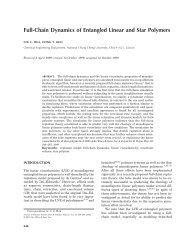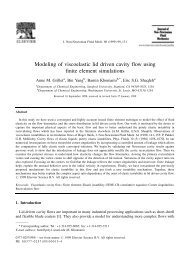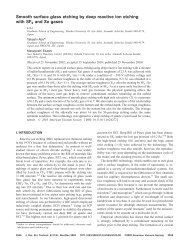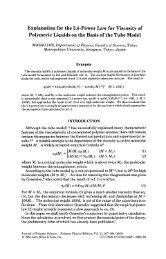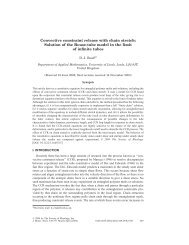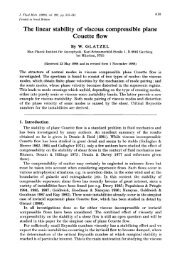A numerical study of the rheological properties of suspensions of ...
A numerical study of the rheological properties of suspensions of ...
A numerical study of the rheological properties of suspensions of ...
You also want an ePaper? Increase the reach of your titles
YUMPU automatically turns print PDFs into web optimized ePapers that Google loves.
168 M. B. Mackaplow and E. S. G. ShaqfehVolume fraction <strong>of</strong> fibres, q0 0.005 0.010 0.015 0.020 0.025Q0 2 4 6 8 10 12 14n13FIGURE 2. Normalized extra particle stress, Q, <strong>of</strong> a suspension <strong>of</strong> aligned, spheroidal fibres withaspect ratio, A = 50, as a function <strong>of</strong> <strong>the</strong> suspension volume fraction. Shown are <strong>the</strong> predictions<strong>of</strong> <strong>numerical</strong> simulations, <strong>the</strong> dilute <strong>the</strong>ory (with and without two-body corrections), and <strong>the</strong>semi-dilute <strong>the</strong>ory <strong>of</strong> Shaqfeh & Fredrickson (1990) (both <strong>the</strong> original and modified versions).ln2(2A) = 30. The ability <strong>of</strong> dilute <strong>the</strong>ories that incorporate <strong>the</strong> effects <strong>of</strong> two-bodyinteractions to predict suspension behaviour into <strong>the</strong> semi-dilute concentration regimewas also observed in our previous <strong>study</strong> <strong>of</strong> heat transfer through <strong>suspensions</strong> <strong>of</strong> highlyconducting fibres (Mackaplow et al. 1994).Figure 2 shows a plot <strong>of</strong> Q us. n13 for <strong>suspensions</strong> <strong>of</strong> fibres with an aspect ratio<strong>of</strong> 50. All <strong>of</strong> <strong>the</strong> fibres are aligned with <strong>the</strong> principal axis <strong>of</strong> extension <strong>of</strong> <strong>the</strong> flowfield. As in figure l(b), we see that by using <strong>the</strong> adjusted coefficients in <strong>the</strong> semi-dilute<strong>the</strong>ory <strong>of</strong> Shaqfeh & Fredrickson (1990), an excellent agreement between simulationsand <strong>the</strong>ory can be achieved for n13 >> 1.Figure 3 shows a plot <strong>of</strong> Q us. n13 for <strong>suspensions</strong> with a fixed inclusion volumefraction, 4, <strong>of</strong> 6.67 x . Again, <strong>the</strong>re is a positive deviation from dilute <strong>the</strong>oryfor n13 2 O( 1). Note that Q approaches a constant in <strong>the</strong> semi-dilute regime. This isconsistent with <strong>the</strong> prediction <strong>of</strong> <strong>the</strong> semi-dilute <strong>the</strong>ory that <strong>the</strong> non-dimensionalizedscreening length in a semi-dilute suspension, X/b, is only a function <strong>of</strong> <strong>the</strong> volumefraction <strong>of</strong> <strong>the</strong> suspension. Whereas <strong>the</strong> published semi-dilute <strong>the</strong>ory <strong>of</strong> Shaqfeh &Fredrickson (1990) quantitatively underestimates this value by approximately 20%,by utilizing <strong>the</strong> adjusted coefficients, excellent quantitative agreement is achieved. Asfor <strong>the</strong> previous sets <strong>of</strong> simulations, <strong>the</strong> dilute <strong>the</strong>ory with two-body corrections does agood job <strong>of</strong> predicting <strong>the</strong> suspension rheology over <strong>the</strong> entire range <strong>of</strong> concentrationsstudied.In our previous <strong>study</strong> <strong>of</strong> heat and mass transfer through fibre <strong>suspensions</strong>, similarscalings <strong>of</strong> <strong>the</strong> suspension screening length in <strong>the</strong> semi-dilute regime were observed, aspredicted by <strong>the</strong> <strong>the</strong>ory <strong>of</strong> Fredrickson & Shaqfeh (1989). However, in this previous<strong>study</strong> we found that using <strong>the</strong> <strong>the</strong>oretically predicted value <strong>of</strong> C” and neglecting <strong>the</strong>



